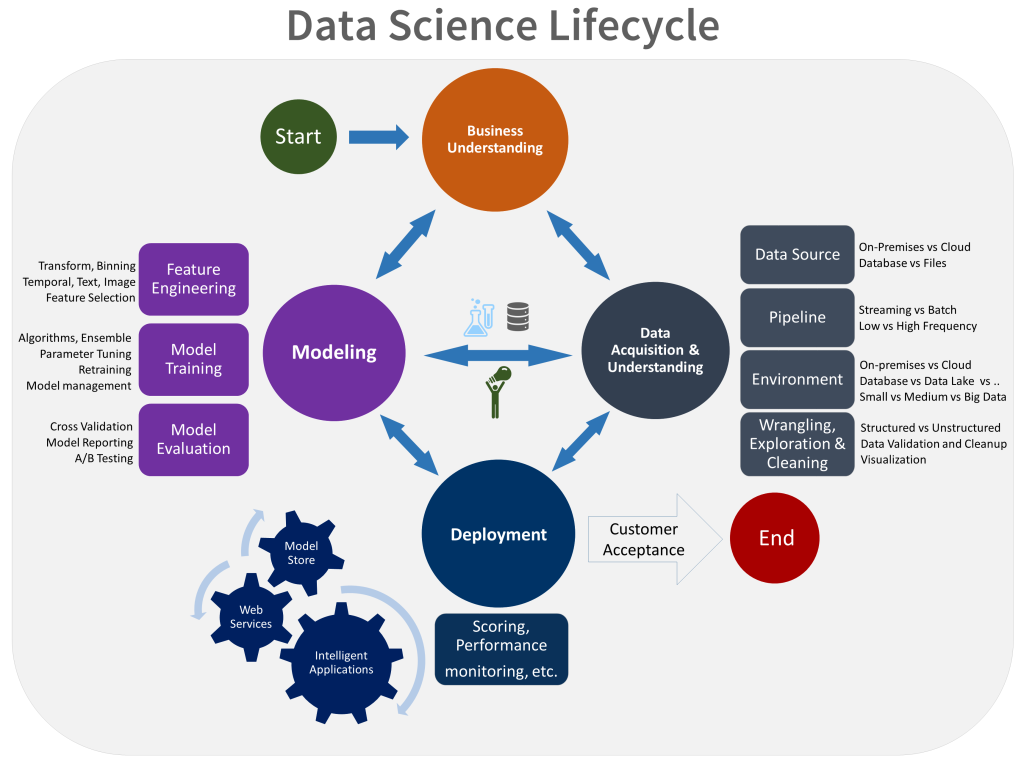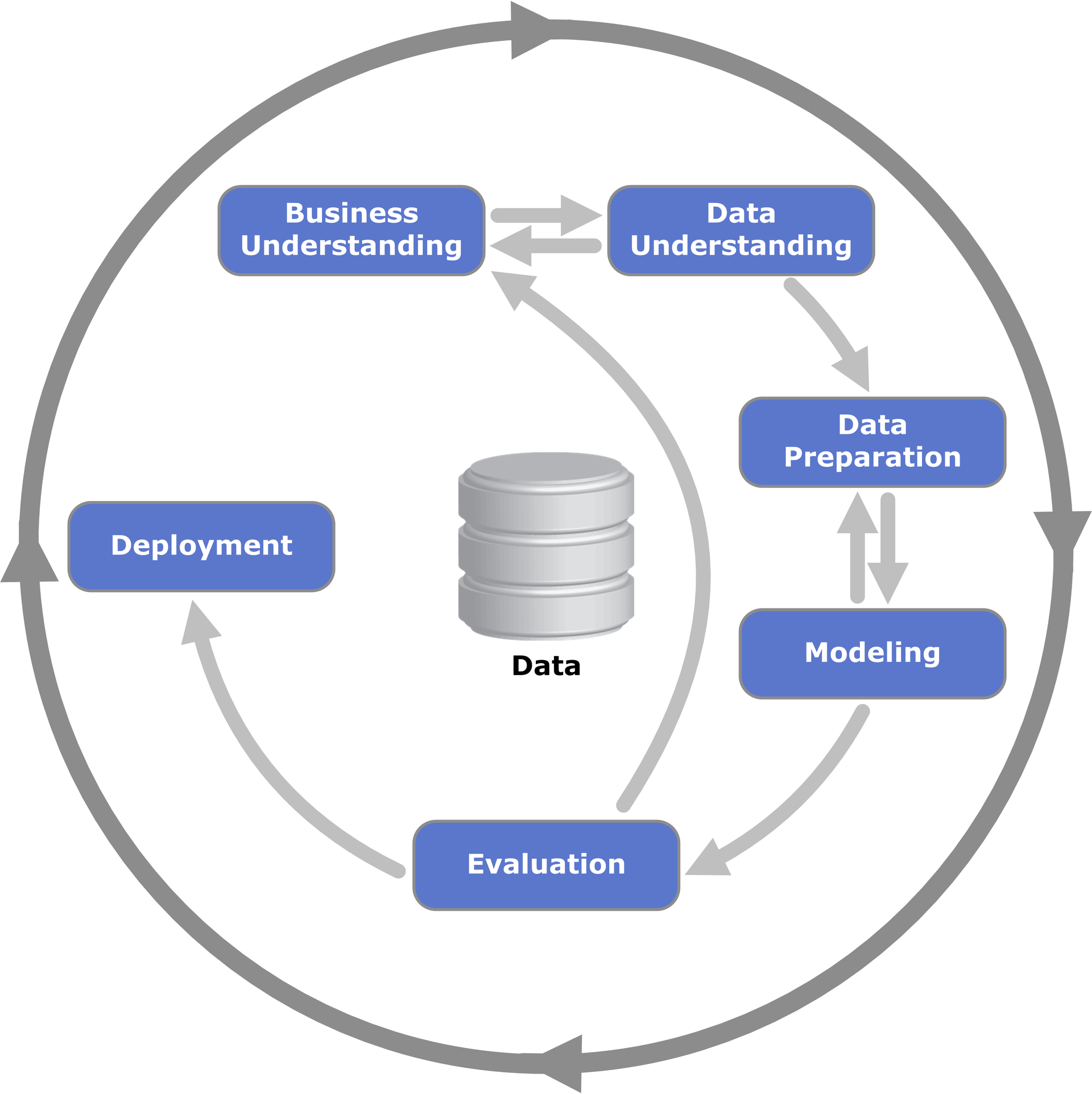
When it comes to designing, developing and implementing a project related to data mining/ machine learning or deep learning, it is always better to follow a framework for streamlining the project flow.
It is OK to adapt a software development framework such as scrum, or waterfall method to manage a ML related project but I feel like having more streamlined process which pays attention on data would be an advantage for the success of a such project.
To my understanding there can be two variations of ML related projects.
- Solely machine learning/ data science based projects
- Software development projects where ML related services are a sub component of the main project.
The step-by step process am explaining can be used in both of these variations with your own additions and modifications.
Basically this is what I do when I get a ML related project to my hand.
I follow the steps of a good old standard process known as Cross-industry standard process for data mining (CRISP-DM) to streamline the project flow. Let’s go step by by step.
Step 1 : Business understanding
First you have to identify what is the problem you going to address with the project. Then you have to be open minded and answer the following questions.
- What is the current situation of this project? (whether it is using some conventional algorithm to solve this problem etc. )
- Do we really need to use machine learning to solve this problem? ( Using ML or deep learning for solving some problems maybe over engineering. Take a look whether it is essential to use ML to do the project.)
- What is the benefit of implementing the project? (ML projects are quite expensive and resource hungry. Make sure you get the sufficient RoI with the implementation.)
- What are constraints, limitations and risks? ( It’s always better to do a risk assessment prior the project. The data you have to use may have compliance issues. Look on those aspects for sure!)
- What tools and techniques am going to use? ( It maybe bit hard to determine the full tech stack you going to use before dipping your feet into the project. But good have even a rough idea on the tools, platforms and services you going to use to development and implementation. DON’T forget implementation phase. You may end up having a pretty cool development which maybe hard to implement with the desired application. So make sure you know your tool-set first)
Tip : If you feel like you are not having experience with this phase, never hesitate to discuss about it with the peers and experts in the field. They may come-up with easy shortcuts and techniques to make your project a success.
Step 2 : Data understanding
Data is the most vital part of any data science/ ML related project. When it comes to understanding the data, I prefer answering these questions.
- How big/small the data is? (Sometimes training deep learning models may need a lot of annotated data which is hard to find)
- How credible/ accurate the data is?
- What is the distribution of data?
- What are the key attributes and what are not-so-important attributes in data?
- How the data has been stored? (Data comes in CSVs/JSONs or flat files etc.)
- Simple statistical analysis of data?
Before digging into the main problem, you can save a lot of time by taking a closer look on data that you have or that you going to get.
Step 3 : Data preparation
To be honest, this step takes 80% of total project time most of the times. Data that we find in real world are not clean or in the perfect shape. Perfectly cleaned and per-processed data will save a lot of time in later stages. Make sure you follow the correct methodologies for data cleansing. This step may include tasks such as writing dataloaders for your data. Make sure to document the data preparation steps you did to the original dataset. Otherwise you may get confused in later stages.
Step 4 : Modelling
This is the step where you actually get the use of machine learning algorithms and related approaches. What I normally do is accessing the data and try some simple modelling techniques to interpret the data I have. For an example, will say I have a set of images to be classified using a artificial neural network based classifier… I’d first use a simple neural network with one or two hidden layers and see if the problem formation and modelling strategy is making any sense. If that’s successful, I’ll move for more complex approaches.
Tip : NEVER forget documentation! Your project may grow exponentially with thousands of code lines and you may try hundreds of modelling techniques to get the best accuracy. So that keep clear documentation on what you did to make sure you can roll back and see what you have done before.
Step 5 : Evaluation
Evaluating the models we developed is essential to determine whether we have done the right thing. Same as software review processes I prefer having a set framework to evaluate the ML projects. Make sure to select appropriate evaluation matrix. Some may not indicate the real behaviour of the models you build.
When performing a ML model evaluation, I plan ahead and make a set structure for the evaluation report. It makes the process easy to compare it against different parameter changes of the single model.
In most of the cases, we neglect the execution or the inference time when evaluating ML models. These can be vital factors in some applications. So that plan your evaluation wisely.
Step 6 : Deployment & Maintenance
Deployment is everything! If the deployment fails in the production, there’s no value in all the model development workload you did.
You should select the technologies and approaches to deliver the ML services (as REST web services, Kubernetes, container instances etc. ). I personally prefer containerising since it’s neat and clean. The deployed models should be monitored regularly. Predictions can get deviated with time. Sometimes data distribution can be changed. Make sure you create a robust monitoring plan beforehand.
Tip : What about the health of the published web endpoints or the capacity of inference clusters you using?? Yp! Make sure you monitor the infrastructure too.

This is just a high-level guideline that you can follow for streamlining data science/machine learning related tasks. This is a iterative process. There’s no hard bound rules saying you MUST follow these steps. Microsoft has introduced team data science process (TDSP) adapting and improving this concept with their own tool-sets.
Key takeaway : Please don’t follow cowboy coding for machine learning/ data science projects! Having a streamline process is always better! 🙂
 When it comes to a machine learning or data science related problem, the most difficult part would be finding out the best approach to cope up with the task. Simply to get the idea of where to start!
When it comes to a machine learning or data science related problem, the most difficult part would be finding out the best approach to cope up with the task. Simply to get the idea of where to start!